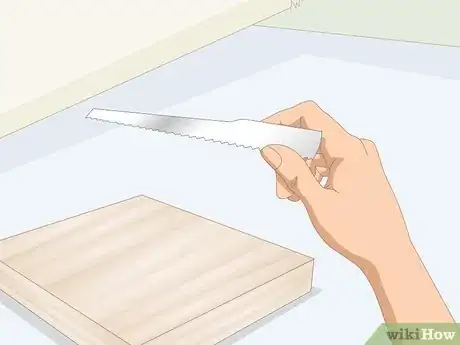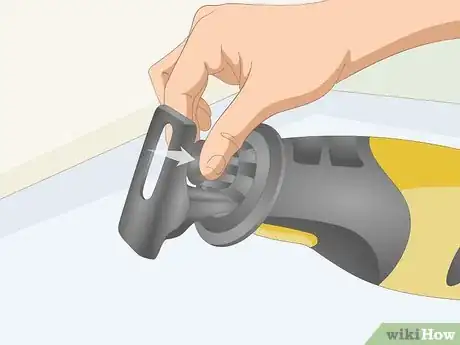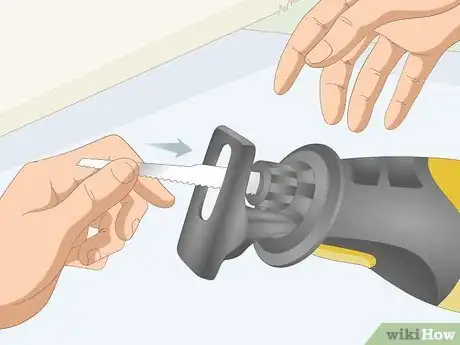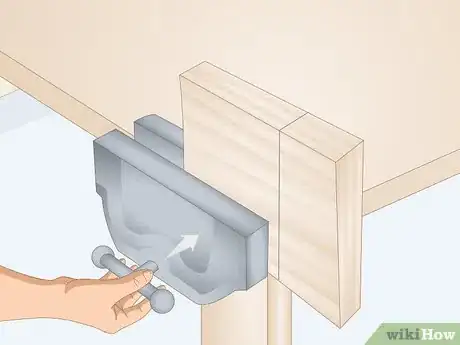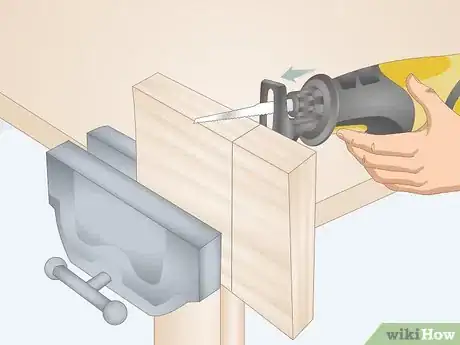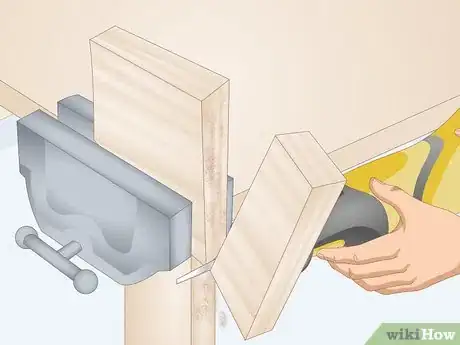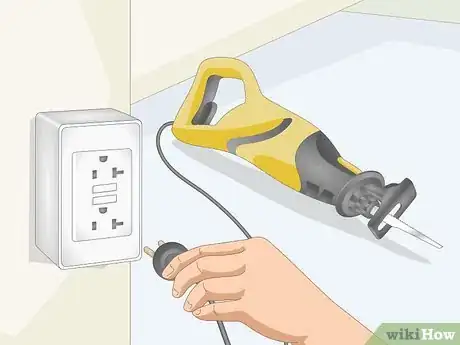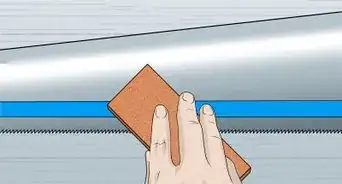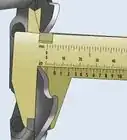This article was co-authored by wikiHow staff writer, Hunter Rising. Hunter Rising is a wikiHow Staff Writer based in Los Angeles. He has more than three years of experience writing for and working with wikiHow. Hunter holds a BFA in Entertainment Design from the University of Wisconsin - Stout and a Minor in English Writing.
There are 10 references cited in this article, which can be found at the bottom of the page.
This article has been viewed 21,258 times.
Learn more...
A reciprocating saw, also known as a recip saw or the brand name Sawzall, has a blade that moves back and forth to cut through materials like wood, pipes, nails, and drywall. Reciprocating saws are usually used for demolition, but their versatility makes them a tool perfect for any DIYer. If you want to start using a reciprocating saw, make sure you attach the right blade for the material you’re cutting. Hold the saw firmly in your hand and guide the blade through the material. Just be mindful of the blade so you don’t cut yourself.
Steps
Choosing and Installing the Blade
-
1Unplug the cord or remove the battery pack. Make sure the saw doesn’t have any power while you’re installing the blade so you don’t accidentally injure yourself. If you have a corded reciprocating saw, unplug it from the electrical outlet. If you have a wireless saw, look for the switch on the bottom of the saw by the box-shaped battery pack. Click the switch to release the battery.[1]
- Buy a reciprocating saw from your local hardware store. Ask if the store offers equipment rentals if you don’t want to buy your own saw.
- Never install or change the blade while the saw is still connected to power.
-
2Select a blade made to cut through the material you have. Reciprocating saws have a variety of blades that you can choose from depending on what you’re cutting. Look at the side of the blade to see if it lists the material that it’s meant to cut through. Choose a blade that’s about 2–3 inches (5.1–7.6 cm) longer than the thickness of the material you’re cutting through so the blade doesn’t wobble around.[2]
- You can buy sets of reciprocating saw blades from your local hardware store.
Types of Saw Blades
Use a wood-cutting blade for standard plywood pieces.
Pick a metal-cutting blade if you’re cutting through pipes or solid metal pieces.
Choose a wood and nail blade if you’re cutting through studs or roofing material that could contain nails.
Opt for a pruning blade if you plan on cutting tree branches.Advertisement -
3Press down the lever or button on the saw’s chuck. The chuck is the cylindrical metal piece on the end of the reciprocating saw that holds the blade in place. Look for a small lever or button, which is usually black or red, on the side of the column and press it down to unlock the chuck. Keep holding it down until you insert the blade.[3]
- If you have trouble finding the button to unlock the chuck, check the saw’s user manual to locate it.
-
4Slide the blade into the slot and let go of the lever. Position the teeth of the saw blade so they point down toward the handle. While you’re holding the lever or button down, slide the blunt end of the blade into the slot at the end of the saw. Let go of the lever or button to secure the blade in the saw. Give the blade a light tug to make sure it doesn’t pull out of the chuck.
- You can also install the blade so the teeth point up. This works well for cutting floor plates in wood framing or objects close to the ground so the handle isn’t in the way.
-
5Adjust the shoe to stabilize the blade and adjust its length. The shoe is the metal piece that goes around the base of the blade that helps you control the saw easier. Grip the sides of the shoe to press down on the buttons and carefully extend it out from the saw. Make sure the blade is at least 1 inch (2.5 cm) longer than the thickness of the material you’re cutting before releasing the shoe. Plug the saw back in or install the battery pack when you finish adjusting the shoe.[4]
- You don’t have to adjust the shoe for every cut, but it can help protect the blade from getting damaged or wobbling while you’re cutting.
Prepping the Material and Work Surface
-
1Draw the line you want to cut on the material. Use a pencil or a marker to draw the line on the surface so you know where to make your cut. If you plan on making a straight cut, use a straightedge as a guide. If you want a curved cut, use a curve template tool or a compass for your marks.
- If you’re trimming branches off of trees with your saw, make your cuts as close to the main trunk as you can.
-
2Clamp the material to your work surface if you’re able. Put the section that you’re cutting so it overhangs your work surface. Attach a C-clamp to the piece of material you’re cutting and tighten against your work surface. If the piece still moves or shifts around when you push it, secure it to your work surface with another clamp.[5]
- You can buy C-clamps from your local hardware store.
- If you’re cutting through pipes, use clamps specifically made for pipes so they’re less likely to roll or slip around while you’re cutting.
-
3Wear safety glasses and earplugs while you’re working. Reciprocating saws can kick back and throw scraps of material. Put on safety glasses that completely cover your eyes any time you start working with a reciprocating saw so you stand protected. Since the saw can be loud while it’s cutting through material, put in earplugs so you don’t damage your hearing.[6]
- You may also choose to wear a dust mask while you’re working, though it isn’t required.
-
4Hold the reciprocating saw firmly with both hands. Grab the front of the reciprocating saw just behind the chuck with your nondominant hand to support the tool’s weight. Grab the handle that has a trigger at the top or back of the saw with your dominant hand. Keep your finger off the trigger until you’re ready to make your cut.[7]
- Always use 2 hands to hold the saw, or else the tool will shake and vibrate when you try to use it.
Warning: If you’re cutting into a wall and there’s a risk of going through wiring, hold the saw by the areas that have rubber insulation to avoid getting shocked.
Making Your Cuts
-
1Press the shoe against the material to stabilize the saw. Position the blade at the end of the line you drew for your cut so the shoe sits flat against the material’s surface. Apply a firm amount of pressure to the shoe to prevent the saw from kicking back while you’re working. Make sure the blade doesn’t touch the material at all, or else it won’t make a clean cut once you start the saw.[8]
- If you’re cutting a rounded object, just press the shoe as tightly against it as possible so it doesn’t slip around.
-
2Pull the trigger to bring the saw to full speed. Use your index finger to lightly squeeze the trigger of the saw so the blade starts moving back and forth. Continue holding the trigger down until the saw reaches its top speed so you can make the cleanest and fastest cut. Whenever you want to stop the blade, let go of the trigger.
- If you’re working with the saw upside-down, use your ring finger or middle finger to pull the trigger instead.
Tip: Some saws have variable speed settings. If you’re cutting through a soft material, like wood or drywall, use the faster setting. For hard materials, use a slow setting so you don’t break the blade.
-
3Guide the blade straight through the material. Keep the shoe pressed firmly against the material you’re cutting so the blade is perpendicular to it. Slowly push the blade along the line you’re cutting without forcing it through the material. Let the saw do most of the work and keep the blade straight as you make your cut so you don’t bend or break the blade. Once you reach the end of your cut, let go of the trigger before pulling the saw out.[9]
- Try changing the angle of your blade as you cut through the material to help reduce the surface area and make the cut faster.
- Never pull the saw blade out of the material while holding the trigger down since the blade could catch and cause the material to kick back toward you.
-
4Make a plunge cut by pressing the blade tip through the material. Set the bottom of the saw’s shoe against the material you’re cutting so the blade is parallel to the surface you’re cutting. Pull the trigger and tilt the saw up so the blade goes into the material at a 30- or 45-degree angle. Continue tilting the saw until it’s perpendicular to the material and the blade has gone completely through to the other side.[10]
- Plunge cuts work perfectly for cutting holes in walls or the middle of large panels.
- If you’re making a plunge cut into a wall, make sure there aren’t any wires or pipes behind the drywall since your saw will easily cut through them.
-
5Disconnect power and store the saw on its side. When you’re finished cutting, press the button on the side of the battery pack to remove it from the saw. If you have a wired reciprocating saw, unplug the cord as soon as you’re finished working. Keep the saw on its side so the blade is parallel to the ground to prevent it from bending or breaking.
- You can also remove the blade after each use if you want.
Warnings
- Be mindful of where the blade is pointed so you don’t injure yourself.⧼thumbs_response⧽
- Avoid wearing loose-fitting clothes since they could get caught in the saw blade.⧼thumbs_response⧽
- Hold the saw firmly with 2 hands so it doesn’t kick back.⧼thumbs_response⧽
- Always wear safety glasses and earplugs while you’re working so you stay protected.⧼thumbs_response⧽
Things You’ll Need
- Reciprocating saw
- Reciprocating saw blade set
- Safety glasses
- Earplugs
- Clamps
References
- ↑ https://youtu.be/8F2Owjt8Qpw?t=30
- ↑ https://bestsawguide.com/how-to-use-a-reciprocating-saw/
- ↑ https://youtu.be/8F2Owjt8Qpw?t=45
- ↑ https://youtu.be/sEwece5mW8c?t=28
- ↑ https://youtu.be/KRzU06csfPs?t=739
- ↑ https://youtu.be/KRzU06csfPs?t=533
- ↑ https://images.homedepot-static.com/catalog/pdfImages/7c/7c286b7c-c0cd-4df1-af0f-26f78a01fe70.pdf
- ↑ https://youtu.be/CZv4zKfYkLA?t=201
- ↑ https://youtu.be/KRzU06csfPs?t=789

